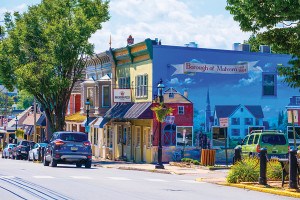3 Ways the Coronavirus Crisis Is Expected to Shape Housing Prices in and Around Philly
Here’s what to expect from the real estate market in the city and suburbs amid a rocky economy.

What will the coronavirus crisis mean for the local real estate market? Photograph by Claudia Gavin
Robin Gordon of BHHS Fox & Roach Realtors recently told me a story: Clients of hers, a couple, had moved from Gladwyne into the city two years ago. They were renting until they could find something they liked. But now, they’re moving to Wayne instead. Does that story sum up the shift we’ll see in the market? Here, three ways COVID is expected to shape housing prices in and around Philly.
Despite a rocky economy, the real estate market will — mostly — stay strong.
One thing most experts agree on: The home has become a locus of activity. And that means people might seek out more space and something different from what they currently have, which will help keep house prices and sales volume high, explains Kevin Gillen, senior research fellow at Drexel University’s Lindy Center for Urban Innovation. (Low interest rates will contribute, too.)
On the other hand, Ken Weinstein, president of Philly Office Retail, predicts that areas where housing is densely packed and tighter by nature (looking at you, city rowhomes and condos) could see a value drop of anywhere from 20 to 40 percent over the next year or two.
The suburban market will boom again.
See: above. People wanting more space for a COVID-adjusted lifestyle and some (literal) breathing room will head to the suburbs, which are already seeing a jump in housing prices. This is particularly true of towns that offer a little urban flair (walkable downtowns, train stations), like Ardmore, Doylestown, Jenkintown, Media and Wayne.
But it’s not just Philadelphians moving out: Gordon notes that housing prices in the Greater Philadelphia market are lower than in most other large metros, so people from beyond the region are also scoping suburban houses here. “These people can all work remotely, and they figure they can live here and work from home,” she says. Since this is the new M.O., why not get the most bang for your buck?
Some city neighborhoods will hold their own.
Weinstein has done very well betting on “middle neighborhoods” — city blocks where residents have household incomes between 80 and 120 percent of the metropolitan-area median. One example is Mount Airy, where prices remain reasonable and houses come with things like yards and extra rooms — both highly appealing post-COVID. In nearby Germantown, prices have risen sharply in the past year.
Gillen cautions that the ongoing protests following the death of George Floyd could send some skittish middle-class families moving beyond city borders. But he also notes that cities are in better shape these days than when riots in the 1960s sent several into tailspins from which they have yet to recover. So, city-dweller: If you’re looking for that extra room, expect stiff competition in the months to come. But if you’re looking to cash out on your house in a hot neighborhood, you might want to stay put while prices are on pause.
Published as “When Bigger Is Better” in the August 2020 issue of Philadelphia magazine.


